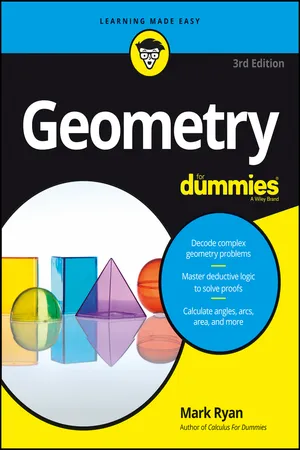Geometry For Dummies
About this book
Hit the geometry wall? Get up and running with this no-nonsense guide!
Does the thought of geometry make you jittery? You're not alone. Fortunately, this down-to-earth guide helps you approach it from a new angle, making it easier than ever to conquer your fears and score your highest in geometry. From getting started with geometry basics to making friends with lines and angles, you'll be proving triangles congruent, calculating circumference, using formulas, and serving up pi in no time.
Geometry is a subject full of mathematical richness and beauty. But it's a subject that bewilders many students because it's so unlike the math they've done before—it requires the use of deductive logic in formal proofs. If you're having a hard time wrapping your mind around what that even means, you've come to the right place! Inside, you'll find out how a proof's chain of logic works and even discover some secrets for getting past rough spots along the way. You don't have to be a math genius to grasp geometry, and this book helps you get un-stumped in a hurry!
- Find out how to decode complex geometry proofs
- Learn to reason deductively and inductively
- Make sense of angles, arcs, area, and more
- Improve your chances of scoring higher in your geometry class
There's no reason to let your nerves get jangled over geometry—your understanding will take new shape with the help of Geometry For Dummies.
Frequently asked questions
- Essential is ideal for learners and professionals who enjoy exploring a wide range of subjects. Access the Essential Library with 800,000+ trusted titles and best-sellers across business, personal growth, and the humanities. Includes unlimited reading time and Standard Read Aloud voice.
- Complete: Perfect for advanced learners and researchers needing full, unrestricted access. Unlock 1.4M+ books across hundreds of subjects, including academic and specialized titles. The Complete Plan also includes advanced features like Premium Read Aloud and Research Assistant.
Please note we cannot support devices running on iOS 13 and Android 7 or earlier. Learn more about using the app.
Information
Getting Started with Geometry Basics
Introducing Geometry
Studying the Geometry of Shapes
One-dimensional shapes
Table of contents
- Cover
- Title Page
- Table of Contents
- Introduction
- Part 1: Getting Started with Geometry Basics
- Part 2: Introducing Proofs
- Part 3: Triangles: Polygons of the Three-Sided Variety
- Part 4: Polygons of the Four-or-More-Sided Variety
- Part 5: Working with Not-So-Vicious Circles
- Part 6: Going Deep with 3-D Geometry
- Part 7: Placement, Points, and Pictures: Alternative Geometry Topics
- Part 8: The Part of Tens
- About the Author
- Connect with Dummies
- End User License Agreement
